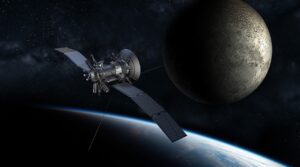
Introduction:
As humanity continues to reach for the stars, the quest for efficient and sustainable energy sources becomes crucial. In the vast expanse of space, where conventional power sources are impractical, solar power emerges as the beacon guiding our cosmic exploration. In this blog, we delve into the trans-formative role of solar power in space, exploring its applications, advancements, and the profound impact it has on our understanding of the cosmos.
Powering the Cosmos: Solar Panels beyond Earth:
In the unforgiving environment of space, traditional power sources like fossil fuels or batteries have severe limitations. Solar power, however, provides a versatile and sustainable solution for meeting the energy demands of spacecraft, satellites, and even future lunar or Martian colonies.
Spacecraft, equipped with solar panels, harness the sun’s energy to generate electricity. These solar arrays, composed of photovoltaic cells, efficiently convert sunlight into electrical power. Unlike batteries that have a finite lifespan, solar panels can generate electricity as long as they are exposed to sunlight, making them indispensable for extended missions in space.
Solar Sails: Riding the Photonic Breeze:
Beyond stationary solar panels, solar sails represent a revolutionary concept in space propulsion. Utilizing the pressure of sunlight, solar sails provide a continuous acceleration without the need for conventional rocket fuel. Thin, reflective sails capture photons from the sun, imparting momentum and propelling spacecraft across the cosmos.
Solar sails offer a sustainable and cost-effective alternative for deep space exploration. Concepts like the Breakthrough Starshot project envision using solar sails to propel tiny spacecraft at a fraction of the speed of light to neighboring star systems, revolutionizing our ability to explore the universe.
Mars Rovers and Lunar Exploration:
Solar power has played a pivotal role in the exploration of our celestial neighbors. Mars rovers, such as Spirit, Opportunity, and Curiosity, have relied on solar panels to generate electricity for their scientific instruments and communication systems. The success of these missions underscores the resilience and effectiveness of solar power in the harsh conditions of the Martian surface.
Similarly, lunar exploration missions, past and future, leverage solar power for sustained energy supply. Solar panels on lunar rovers and landers ensure a continuous power source during lunar day, enabling scientific experiments, data collection, and communication with Earth.
The International Space Station (ISS): A Solar-Powered Oasis:
In the micro-gravity environment of the International Space Station (ISS), large solar arrays unfurl like giant wings, providing a constant supply of electricity. The ISS relies entirely on solar power to meet the energy needs of its scientific experiments, life support systems, and communication equipment.
The success of the ISS demonstrates the scalability and reliability of solar power in sustaining human life and scientific endeavors in the harsh conditions of space. As we envision long-duration space missions and the establishment of lunar or Martian bases, solar power emerges as a linchpin in ensuring the sustainability of these extraterrestrial habitats.
Advancements in Space Solar Technology:
Continual advancements in solar technology enhance its efficiency and applicability in space. Deployable solar arrays, which can be folded for efficient transport and then unfurled in space, maximize the surface area exposed to sunlight. High-efficiency solar cells, such as multi-junction cells, boost power output, allowing for more compact and powerful solar arrays.
Innovations like thin-film solar cells and advanced concentrator systems enhance the power generation capabilities of space-based solar panels. These technologies not only improve the performance of existing space missions but also open the door to more ambitious and energy-intensive projects.
Challenges and Future Prospects:
While solar power in space has proven immensely successful, challenges persist. Extended missions to outer planets or interstellar space face the limitation of diminishing sunlight intensity with distance. Energy storage solutions and advancements in propulsion systems are crucial for overcoming these challenges and ensuring the viability of deep space exploration.
Looking ahead, the integration of solar power into space habitats and the development of in-situ resource utilization on celestial bodies will be pivotal. Utilizing local resources, such as lunar regolith or Martian soil, to manufacture solar panels could potentially reduce the reliance on Earth for space-based energy infrastructure.
Conclusion: Illuminating the Cosmos with Solar Brilliance:
The marriage of solar power and space exploration marks a paradigm shift in our ability to venture beyond our home planet. From powering spacecraft and rovers to propelling missions to the edges of our solar system, solar technology has become an indispensable tool in humanity’s cosmic toolkit.
As we set our sights on the moon, Mars, and beyond, the significance of solar power in space cannot be overstated. It not only ensures the success of current missions but also paves the way for a future where sustainable and renewable energy sources become the lifeblood of our endeavors beyond Earth. The sun, our constant cosmic companion, continues to light the way for humanity as we reach new frontiers and illuminate the mysteries of the cosmos.
